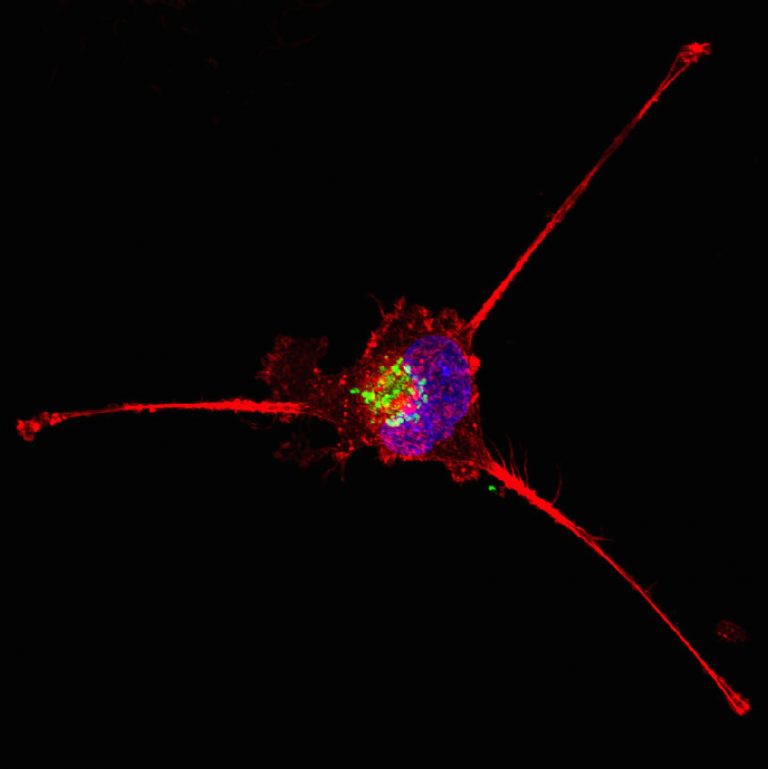
Increasing scientific evidence supports the involvement of the enzyme MAPK4 in cancer growth and resistance to certain therapies, and scientists headed by a team at Baylor College of Medicine have now reported that MAPK4 may play an important role in triple-negative breast cancer (TNBC).
Analyzing public genomic datasets, the researchers discovered that a large subset of TNBC expresses significant levels of MAPK4. Their studies showed that eliminating MAPK4 reduced human TNBC cell growth in animal models and sensitized the cells to therapies that block PI3K, a known cancer growth-promoting signaling pathway. The investigators suggest that their findings support further studies evaluating the potential that targeting MAPK4 in TNBC might offer improved treatments.
“In this work, we have combined two long-term interests of my lab: studying the role MAPK4 plays in human cancers and better understanding breast cancer, the most commonly diagnosed cancer worldwide,” said Feng Yang, PhD, assistant professor of molecular and cellular biology and a member the Dan L. Duncan Comprehensive Cancer Center at Baylor. “In particular, this study focused on TNBC, the subtype of breast cancer that is the hardest to treat.” Yang is corresponding author of the team’s published paper in Nature Communications, which is titled, “MAPK4 promotes triple negative breast cancer growth and reduces tumor sensitivity to PI3K blockade.”
About 15–20% of all breast cancers (BCa) are TNBC, a devastating disease with limited therapeutic options, the authors noted in their paper. Aberrations in the PI3K/PTEN signaling pathway are common in TNBC, they pointed out, but the therapeutic impact of PI3K inhibition against TNBC has been limited, and the mechanism(s) underlying this lack of efficacy remain elusive.
For their reported studies, Yang and colleagues first analyzed the gene expression profiles of 817 human breast cancers in the Cancer Genome Atlas dataset, including a variety of breast cancer subtypes. They found that MAPK4 expression was elevated in 30% or more of the basal-like breast cancer subtype, 70–80% of which are TNBC.
The team, in addition, analyzed MAPK4 expression in the breast cancer patient-derived xenograft (PDX) collection from Baylor’s cancer center, the majority of which are TNBC. PDX refers to a type of animal model of human cancer that closely recapitulates the human condition. In a large subset of the TNBC PDX tumors, Yang and his colleagues also found high expression of MAPK4. “Altogether, these data support that MAPK4 is expressed at significant levels in a large subset of TNBC/basal-like BCa,” they wrote.
“Previous work from our lab had shown that MAPK4 can play a cancer-promoting role in other cancer types, such as prostate cancer,” Yang said. “Finding that the levels of MAPK4 are elevated in a significant subset of TNBC prompted us to investigate whether MAPK4 could also contribute to TNBC.”
In seven different human TNBC cell lines, some expressing higher levels and others expressing lower levels of MAPK4, the team manipulated MAPK4 gene expression levels. After eliminating MAPK4 by either knockdown or knockout approaches, the cells’ growth was significantly reduced, suggesting that MAPK4 plays a part in TNBC. The researchers also increased the levels of MAPK4 in low-expressing TNBC and this promoted cell growth. Together, these findings supported a role for MAPK4 in TNBC growth.
Yang and collaborators next dug deeper into the mechanism behind MAPK4’s cancer-promoting role in TNBC. “We had previously found that MAPK4 promotes growth in other cancer types by activating in cells a cancer-promoting signaling pathway called AKT,” Yang said. As the authors stated, “We recently reported that MAPK4 is a key oncogenic kinase promoting cancer via non-canonical activation of AKT/mTOR independent of PI3K/PDK1.” Yang continued, “Here we showed that this is also the case in TNBC.”
TNBC can activate AKT via two independent mechanisms: one mediated by MAPK4 and the other by another enzyme called PI3K, as previously described. “We knew that alterations in the PI3K pathway were common in TNBC, but yet the therapeutic benefits of PI3K inhibitors were limited,” Yang said. “Here we provide a mechanism that can explain the inhibitors’ lack of efficacy.”
The team proposed that inhibiting PI3K would leave the cells with the possibility of activating AKT via MAPK4 and thus continue to grow. Confirming this idea, the researchers found that knocking down MAPK4 resulted in the cells being sensitive to PI3K inhibitors and reducing cancer growth, Also, overexpressing MAPK4 in low-expressing TNBC empowered the cells to resist the effect of PI3K inhibitors and continue to grow. The authors concluded, “Our current data further confirmed the indispensable role of AKT activation in mediating MAPK4 activity in promoting TNBC growth … Altogether, we conclude that high MAPK4 expression defines a large subset or subtype of TNBC responsive to MAPK4 blockage. Targeting MAPK4 in this subset/subtype of TNBC both represses growth and sensitizes tumors to PI3K blockade.”
The authors suggest that their data define MAPK4 as “a bona fide oncogene” and indicate that the MAPK4-high subset may represent a unique subtype of TNBC that would be sensitive to MAPK4 inhibition. “Although there are currently no identified specific MAPK4 inhibitors, the current results provide further impetus for their development and for future studies to critically examine their efficacy, either as monotherapy or in combination with chemotherapy or radiation therapy, in treating MAPK4-high TNBC.”
“Altogether, our findings suggest a new therapeutic opportunity for TNBC based on MAPK4 expression, perhaps including a combination of inhibitors to help control cancer growth,” Yang said. “Future studies will help clarify this idea.” As the authors further concluded, “It will also be interesting to assess whether MAPK4 expression/activity is induced in TNBC that gain resistance to PI3K inhibition and whether targeting MAPK4 will overcome this acquired resistance.”













